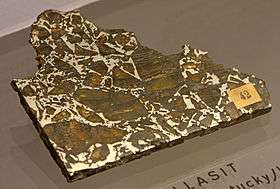Eagle Station group
The Eagle Station group (abbreviated PES - Pallasite Eagle Station) is a set of pallasite meteorite specimen that don't fit into any of the other defined pallasite groups. In meteorite classification five meteorites have to be found, so they can be defined as their own group.[1] Currently only five Eagle Station type meteorites have been found, which is just enough for a separate group.[2]
| Eagle Station group | |
|---|---|
| — Group — | |
 Eagle Station meteorite, type specimen for the group. | |
| Type | Stony-iron |
| Class | Pallasite |
| Composition | Meteoric iron, silicates |
| Total known specimens | 5 |
Naming and history
The Eagle Station group is named after the Eagle Station meteorite, the type specimen of the group. It is in turned named after Eagle Station, Carroll County Kentucky where it was found.[3]
Description
The Eagle Station group has a composition similar to Main group pallasites. Diagnostic differences are that the olivine is richer in iron and calcium. The group also has a distinct oxygen isotope signature.[1]
The meteoric iron is similar to the IIF iron meteorites. This might indicate that Eagle station group and IIF formed close to each other in the solar nebula.[1]
Parent body
The trace elements in the phosphates of the Eagle Station group are distinct from other pallasites. Most pallasites are believed to be derived from the core-mantle boundary. Trace elements indicate that the Eagle Station group came from shallower depths of their parent body.[4]
Notable specimen
Only five specimen have been found so far:[2]
- Cold Bay meteorite
- Eagle Station meteorite (type specimen)
- Itzawisis meteorite
- Karavannoe meteorite
- Oued Bourdim 001
See also
References
- D.S. Lauretta, H.Y. McSween, Jr., editors ; foreword by Richard P. Binze; M. K. Weisberg; T. J. McCoy, A. N. Krot (2006). "Systematics and Evaluation of Meteorite Classification". Meteorites and the early solar system II (PDF). Tucson: University of Arizona Press. pp. 19–52. ISBN 978-0816525621. Retrieved 15 December 2012.CS1 maint: multiple names: authors list (link)
- "Meteoritical Bulletin Database". Meteoritical Society.
- "Eagle Station". Meteoritical Society.
- Davis, Andrew M.; Olsen, Edward J. (17 October 1991). "Phosphates in pallasite meteorites as probes of mantle processes in small planetary bodies". Nature. 353 (6345): 637–640. doi:10.1038/353637a0.